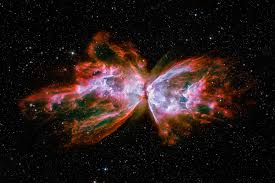
New images released by NASA’s Spitzer Space Telescope have revealed a beautiful red butterfly in space some 1,400 light years away from the sun. But actually it is not a butterfly, but a massive cloud of dust and gas, in shape of a butterfly, which serves as a nursery for hundreds of baby stars. Officially named Westerhout 40 (W40) the butterfly, is a nebula ― a giant cloud of gas and dust in space where new stars are born.
The butterfly’s two “wings” are giant bubbles of hot interstellar gas blowing from the hottest most massive region of stars. Inside the massive clouds of gas and dust, the force of gravity coalesces materials into dense clumps and clusters. Sometimes, when the clumps reach a critical density, stars are formed at the cores of these dense clumps. Radiations and winds spew out millions of tons of gas and dust out into space when those stars eventually explode and subsequently halts new star formation. The Infrared Array Camera (IRAC) on the Spitzer Space Telescope revealed that the red tinge of the W40 nebula is due to the presence of organic molecules of polycyclic aromatic hydrocarbons (PAH) in an excited state.
Some of the youngest stars are surrounded by dusty disks of materials, which glow with a yellow or red hue. The Spitzer Space Telescope is managed by Jet Propulsion Laboratory (JPL) in Pasadena, California while the Science Operations are conducted at Spitzer Science Center at Caltech in Pasadena.

Muhammad Abdullah Khan has done bachelors in Chemistry from Government College University
Lahore. He is a science enthusiast and loves to read and write about astronomy, cosmology and latest
scientific endeavors.

